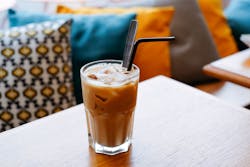Cold Coffee Brews Sales
Cold coffee – iced coffee, cold brew, nitro, and others – may have started as a fad, but is now an important part of many consumers’ daily caffeine routines. These drinks have positively affected the coffee community as new and increasingly popular caffeinated beverages. Cold coffee is important in the breakroom because it is convenient, it increases sales, attracts younger generations and is also the fastest growing in the segment.
Cold coffee is convenient
Cold coffee is convenient because it is readily available. Convenience is about being in a grab and go format allows them to get it when and where they want it, according to the June/July OCS update. It is convenient to grab a cold coffee from a market, which makes it a popular drink option. Consumers are more likely to have cold coffee as a treat from foodservice rather than make it themselves, according to Mintel's 2018 on premise research. Manufacturers and operators delivering so many bottling options has encouraged the popularity of cold coffee by bringing it to the consumer.
Increasing sales
Cold coffee is changing the way consumers buy coffee. Mintel’s Executive Summary of coffee, July 2017, reported an increase in cold brew, growing 460 percent from 2015-2017 in total U.S. sales. This is an indication that consumers are becoming more likely to purchase cold coffee. An advantage for the operator is that RTD cold coffee is commercially brewed which eliminates the challenges of in-house cold brew. A strong penetration of cold coffee is also a factor in increasing sales, according to Mintel’s 2017 report. With the advent of more consumers seeking a broader variety of offerings, they will happily pay a premium to get it.
Younger generations lead the way
Coffee consumption increases with younger generations such as iGen and Millennials, says Mintel’s 2017 coffee report. This is because of the prevalence of new additions such as “healthy” ingredients. Three in ten coffee consumers believe coffee is healthier than other caffeinated beverages, according to Mintel’s 2017 coffee report. The majority of consumers who feel this way are iGen and Millennials. Younger generations of consumers drink coffee for a variety of reasons and live healthy and proactive life styles, which is motivating operators to sell more RTD products that include health and wellness benefits. The rise of “super coffee” pushes coffee health benefits – such as added chia seeds, coconut oil, and protein. This gives operators an opportunity to target health-obsessed younger drinkers seeking added benefits.
Fastest growing segment
In the 2018 on premise research, Mintel forecasts that the RTD coffee segment will experience a 67 percent growth from 2017-2022. “Ready to drink coffee is one of the fastest growing, nonalcoholic beverages in the U.S.; it is convenient, comes in a variety of flavors, and is oftentimes cheaper than specialty coffee at most coffee houses,” said Caleb Bryant, senior foodservice analyst for Mintel.
In 2017, the Mintel global new products database revealed that global new coffee launches have seen growth from 2016 to 2017 and continues to expand. This is up from 16 percent in 2015. These findings highlight the popularity of cold coffees and consumers’ proclivity to purchase it. Relatively speaking, consumers in the U.S. are more likely to drink cold coffee due to its prevalence and popularity. Consumers want more options, and different forms of cold coffee fulfill that desire.
Cold coffee has impacted the coffee industry in a major way. It has become popular for its convenience, especially when available in OCS. Not only is it popular among consumers, it is also driving a growth in sales in the industry. While the younger generations are driving this force, it is clear that cold coffee options are gaining a large foothold amongst all coffee consumers.
